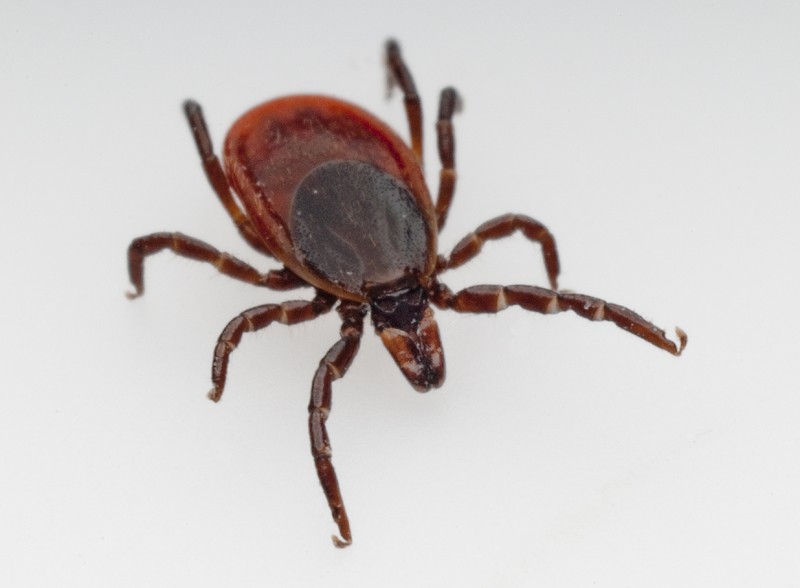For three of four seasons, ticks area an annoying pest that can harbor disease, some even life threatening.
The best way to avoid getting bitten by a tick is to avoid ticks or if you must be in an area where they are, performa very close self-inspection.
How to Avoid Ticks
As with any problem, the best thing you can do about tick-borne illness is to prevent it. So the first, and most important step is to do your best to avoid ticks in the first place.
That’s why when hiking, camping or bugging out, make sure to avoid walking through deep vegetation, high grass and leaf litter. Ticks have a porous outer cover, so they lose moisture rapidly. That’s why they prefer darker, humid places. You should also make sure to walk in the center of the trails as much as possible.
While hiking, camping or bugging out in places where ticks are present, you will want to take the following measures in order to avoid ticks:
• Wear bright colored clothing – while this will not keep ticks at distance, it will be easier for you to detect poppy-seed-sized nymph ticks that might later crawl on your skin to bite. Check for ticks regularly and immediately brush them off your clothes.
• Wear long trousers, tube socks and boots and tuck your trouser inside your socks. It won’t look pretty, but that’s not what you’re aiming for right now. In extreme situations, like highly infested areas, you can wrap some duct tape over the top of your ankles and around your wrists in order to seal any places where the ticks might crawl on your skin.
• Apply Permethrin to clothing, boots and hiking gear, but beware, as Permethrin products should never be used on skin. Permethrin is a pesticide and is sold under the names Permanone and Duranon and it remains active throughout several washings.
• Repellents that contain 20% to 30% DEET (N, N-diethyl-m-toluamide) can be used on exposed skin and clothing, offering protection for several hours. However they are said to be less efficient than Permethrin. DEET is also known to be toxic and possibly carcinogenic and is being used less and less in bug repellants. When applying any type of bug repellant on your skin or your kids’ skin, make sure to avoid the hands, eyes and mouth.
You can also use natural repellents such as:
• Diatomaceous Earth – It is said to be a great natural bug repellent without any toxic effects on humans, animals and plants. Spread it all over you lawn to help keep ticks and other bugs away.
• Lime – It has a similar effect, but it does affect the acidity of your soil, so keep that in mind before using it in your garden.
• A mix of lemon, orange, clove and lavender essential oils. There are many recipes online that you can try and test. Some are kid friendly so keep that in mind if you have little ones running all over the lawn.
Another thing to take into consideration is that ticks can get to your yard easily, increasing your chances of picking them up long after you took a hike or a stroll in the park. If your yard is close to the woods, make sure to use landscaping to set a barrier zone between the two. Use wood chips or gravel in order to create a separating zone. You will also want to discourage unwelcomed visitors (such as deer, raccoons, mice, rats or stray dogs) by fencing your garden.
Although it may sound like a no-brainer, if the risk of tick infestation is high, you will want to use pesticide in order to control the infection. The pesticides used against ticks are called acaricides and are best used in April in order to control the nymphal I. scapularis ticks, which are the most likely to transmit Lyme disease. You can also apply pesticides in October in order to control adult black legged ticks, but they are less likely to transmit diseases once they reach that stage.
If you have pets, they will also easily pick up ticks from walking through high grass when hiking or running in the park, or from interacting with infested pets. Make sure to ask your vet to check your pet for ticks during each visit, but also check them yourself daily at home and immediately remove any tick that you find. Ask your vet for tick preventives you could use on your pet.
How to Check if You Picked Up Any Ticks
As I mentioned earlier, you should check to see if there are any ticks on your clothes while you’re out and about and brush them off immediately. But you also must check as soon as you get to your home or shelter to see if any ticks passed through the clothing barrier and are attached to your skin.
Ticks prefer dark humid places so make sure to check the following spots using a hand held mirror and enlisting someone’s help if there are any spots you can’t reach:
• Your hair
• Behind and in your ears
• Armpits
• Wrists
• Bellybutton
• Between your legs
• Behind your knees
• Waist area
People who shower right after taking a hike are said to be less likely to catch diseases from ticks, as they will find them earlier, before the tick has had a chance to feed and infect its host.
Avoiding a tick bite is critical, especially in a SHTF moment, when getting bit could mean getting sick and that could be deadly.
By taking steps to avoid letting them get in a position to bite you, the risk of infection or disease is reduced to zero.
For more information on combating ticks as well as information on the diseases they can cause and hoe to remove one if you do get bit, please visit Survivopedia.
